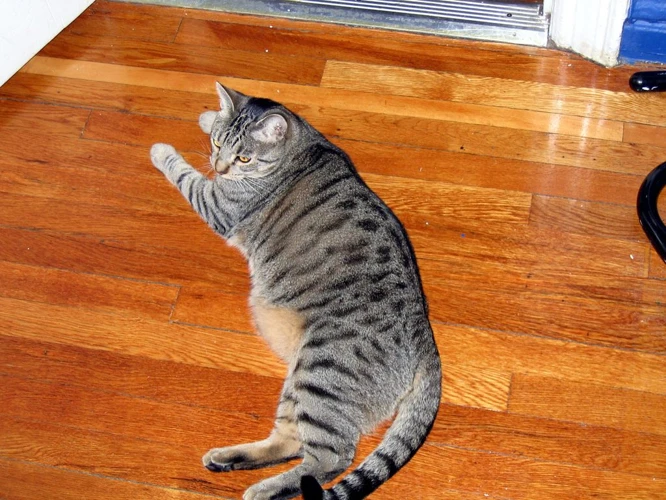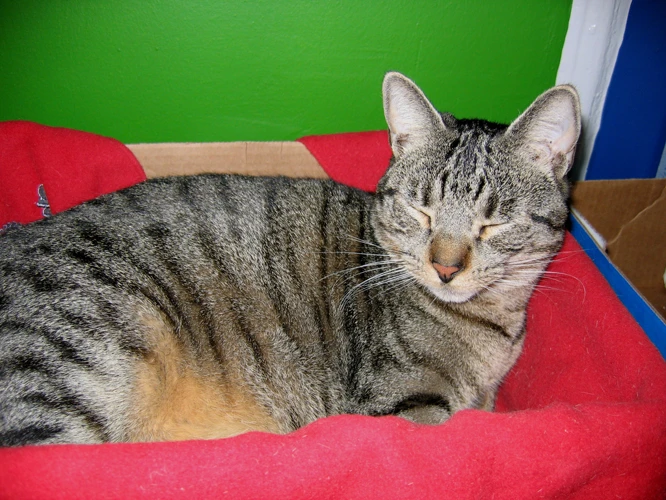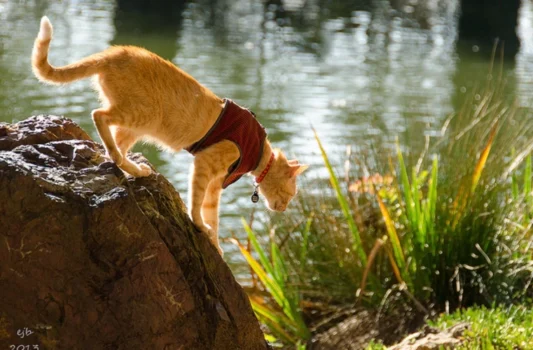One might not immediately think of leash training a cat, but it can actually be a great way to provide your feline friend with exercise, mental stimulation, and safety. In particular, California Spangled cats can benefit from leash training. These unique and athletic cats crave exercise and attention. And although they are known for being independent, they also love spending time with their humans. But how do you go about leash training your California Spangled cat? We’ll explore the many benefits of this activity, when to start training, how to train step-by-step, and some tips to keep in mind. So, let’s dive in and discover why leash training could be a game-changer for your California Spangled cat!
Benefits of Leash Training for California Spangled Cats

Leash training your California Spangled cat might sound like an unusual concept at first, but it can actually offer numerous benefits to your furry friend. Through leash training, you can provide your feline companion with exercise, mental stimulation, and safety, which are all crucial aspects of a cat’s overall well-being. Additionally, leash training can help strengthen your bond with your pet. In this section, we will explore the advantages of leash training for California Spangled cats in greater detail. If you’re interested in learning more about leash training your cat, be sure to check out our Cali Spangled cat leashes article. We will cover everything from starting leash training with your California Spangled kitten to avoiding common mistakes in leash training.
Provides Exercise
One of the primary benefits of leash training for California Spangled Cats is that it provides physical exercise. While cats may seem perfectly content lounging around the house, they actually need physical activity to stay healthy. Without exercise, they can easily become overweight or develop health issues.
Leash training provides a great opportunity for your cat to get some much-needed exercise. Taking your feline friend out for a walk or play session can help them burn off excess energy and stay fit. You can explore the outdoors together, allowing your cat to discover new sights, smells, and sounds.
If you’re just starting to leash train your Cali Spangled, it’s important to keep in mind that they may not immediately take to it. You can refer to our article on starting leash training for your California Spangled kitten to avoid common mistakes and make the process as smooth as possible.
Once your cat is comfortable with the harness, you can gradually increase the distance and duration of your walks. You can also incorporate playtime into your walks, such as chasing a toy or climbing on an obstacle. This will not only provide exercise for your cat but also create a bonding experience for both of you.
Leash training your California Spangled Cat offers numerous benefits, including physical exercise, mental stimulation, and safety. Whether for a casual walk around the block or a more adventurous hike, it’s a great way to keep your cat active and healthy. But remember to start slowly and be consistent, as we discussed in our article about Cali Spangled leash training.
Offers Mental Stimulation
Leash training your California Spangled cat not only provides them with the exercise they need, but it also offers mental stimulation. Cats, especially indoor ones, can often become bored and restless, making them prone to destructive behavior.
Leash training offers an opportunity for your cat to explore their environment and engage with new smells, sights, and sounds. This sensory stimulation can help keep them mentally and physically active, promoting a sense of purpose and well-being.
Additionally, leash training provides opportunities for socialization. When out on a walk, your California Spangled cat may encounter other animals, which can help them learn appropriate behaviors and social cues.
It is important to note that not all cats will take to leash training, and mistakes should be avoided to prevent unnecessary stress for both you and your cat. However, if your cat seems interested and willing to learn, leash training can offer incredible benefits for their overall health and happiness.
To sum up, leash training offers mental stimulation for your California Spangled cat, providing them with opportunities for sensory exploration and socialization. It can help prevent boredom and destructive behavior, promoting a sense of purpose and well-being.
Keeps Them Safe
Leash training is very important for the safety of your California Spangled cat. When you leash train your cat, it prevents the cat from running away or getting lost. Let’s take a look at some of the benefits of leash training and how they provide safety for your cat.
| Benefits of Leash Training for Safety | Explanation |
|---|---|
| Prevent Running Away | When your cat is on a leash, they cannot run away and get lost. It allows you to keep a close eye on them and prevents them from wandering off. |
| Control While Outdoors | With a leash, you can control where your cat goes and what they do when outdoors. This can prevent them from getting into dangerous situations, such as getting too close to a busy road or interacting with other animals. |
| Protect from Predators | Leash training can also protect your cat from predators. When your cat is on a leash, they are less likely to encounter predators that could harm them, such as coyotes or wolves. |
| Provide Identification | When your cat is wearing a harness and leash, they are easily identifiable if they get lost. The identification tags on their collar can help people return them safely to you. |
As you can see, there are many reasons why leash training your California Spangled cat is important for their safety. By keeping your cat on a leash, you can keep them away from danger, prevent them from getting lost, and identify them if they do become lost. So, if you want to ensure the safety of your furry friend, consider leash training your California Spangled cat. For more information on Cali Spangled leash training, click here.
When to Start Leash Training for Your California Spangled Cat

As a cat owner, you may be wondering about the appropriate time to start leash training for your California Spangled cat. It’s a valid question, especially if you’re unfamiliar with the process of leash training. While some cats may take to it naturally, others may require more time and patience. It’s essential to assess your cat’s age and health before introducing them to a harness and leash. By doing so, you can ensure that the experience is positive and enjoyable for both you and your furry friend.
Age Considerations
Age Considerations
When it comes to leash training your California Spangled Cat, age is an important factor to consider. While cats can technically be leash trained at any age, it’s generally recommended to start when they’re kittens, ideally between the ages of 8 and 12 weeks.
| Age Group | Advantages | Disadvantages |
|---|---|---|
| 8-12 weeks |
|
|
| 3-6 months |
|
|
| 6+ months |
|
|
Health Considerations
It’s also important to consider your California Spangled Cat’s health before starting leash training. Cats with certain health conditions, such as arthritis or heart disease, may not be suitable for leash training. Additionally, if your cat is overweight or obese, it’s important to work with your veterinarian to develop a weight loss plan before starting leash training. This can help reduce the risk of injury and make it easier for your cat to move around. Always consult with your veterinarian before starting any new training program with your cat.
Health Considerations
When considering leash training for your California Spangled cat, it is important to take their health into consideration. Here are some health factors to keep in mind:
- Disease Prevention: Before starting any outdoor activities, it is important to ensure your cat is up to date with their vaccinations and parasite prevention. Consult with your veterinarian about any necessary preventive measures before starting the leash training process.
- Physical Condition: Make sure your cat is physically fit enough for leash training. Consider any pre-existing medical conditions that may prevent your cat from walking on a leash, such as arthritis, heart disease, or breathing problems. If you have any concerns, discuss them with your veterinarian before beginning the training process.
- Breeds Predisposition: California Spangled cats are generally healthy and robust breeds. However, some may be prone to certain health issues such as joint problems, obesity, and heart disease. Talk to your veterinarian about any specific concerns you should have regarding your cat’s breed before starting leash training.
- Weather Conditions: The weather can also have a significant impact on your California Spangled cat’s health, especially if they are not used to spending extended periods of time outdoors. Make sure to choose an appropriate time of day and weather conditions for leash training. During hot weather, avoid walking your cat during midday and make sure they have access to shade and water. During cold weather, make sure your cat is dressed appropriately to prevent hypothermia.
By taking these health considerations into account, you can ensure that your California Spangled cat is healthy, happy, and safe during their leash training sessions.
How to Leash Train Your California Spangled Cat

Leash training a California Spangled cat may seem like a daunting task, but it is actually a process that can be accomplished with patience and persistence. Using positive reinforcement methods and a few basic training techniques, you can have your feline friend walking comfortably on a leash in no time. Below are some key steps and tips to help guide you through the process of leash training your California Spangled cat.
Getting Your Cat Used to the Harness
One of the most important aspects of leash training your California Spangled cat is getting them comfortable with wearing a harness. Here are some tips for getting your cat used to the harness:
- Introduce the harness gradually: Start by placing the harness near your cat’s bed or in an area where they spend a lot of time so that they can get used to its presence. You can also leave treats or toys near the harness to create positive associations.
- Let your cat explore the harness: Once your cat seems comfortable with the presence of the harness, let them sniff and explore it without forcing them to wear it. You can try holding the harness near your cat or draping it over their back while giving treats or positive attention.
- Start with short periods of wearing the harness: Once your cat is used to the presence of the harness and has explored it, you can start to put it on them for short periods of time. Make sure the fit is snug but not too tight, and offer treats or praise while they are wearing it to create positive associations.
- Gradually increase the length of time your cat wears the harness: Over time, you can increase the amount of time your cat wears the harness, gradually building up to longer periods of time. Again, make sure to offer positive reinforcement and keep an eye on your cat’s comfort level.
- Avoid forcing your cat to wear the harness: If your cat seems uncomfortable or stressed while wearing the harness, remove it and try again later. It’s important to approach leash training gradually and with patience to ensure that your cat feels comfortable and safe.
By taking the time to get your California Spangled cat comfortable with wearing a harness, you will set them up for success in their leash training journey. Remember to be patient and consistent, and always offer positive reinforcement for good behavior!
Introducing the Leash
Introducing the Leash
Once your California Spangled cat is comfortable wearing the harness, it’s time to introduce the leash. Here are the steps to follow:
| Step | Instructions |
|---|---|
| Step 1 | Attach the leash to the harness while your cat is relaxing indoors. |
| Step 2 | Let your cat roam freely indoors with the leash dragging behind, while you supervise to ensure they don’t get tangled or hurt. |
| Step 3 | Pick up the leash gently and follow your cat as they move around the room. Use treats and positive reinforcement to encourage them to move closer to you. |
| Step 4 | Gradually increase the distance between yourself and your cat as they become more comfortable walking on the leash. |
| Step 5 | Take your cat outside in a familiar and safe environment, such as your backyard, to continue their training on the leash. Watch for any signs of stress and discomfort, and adjust accordingly. |
Note: Be patient and consistent with introducing the leash. Every cat is different, so it may take some time for them to get comfortable. But with patience and positive reinforcement, your California Spangled cat will be happily exploring the outdoors on a leash in no time.
Basic Training Commands
To have a successful leash training experience with your California Spangled Cat, you will need to teach them some basic commands. These commands will help to keep your cat safe and comfortable while out on walks.
One essential command is “heel.” “Heel” indicates to your cat that they should walk close to your legs on a leash. To teach this command, you can use treats and positive reinforcement. Start by walking with your cat and holding a treat close to your leg. As your cat comes closer to you, reward them with the treat and verbal praise. Repeat this exercise until your cat learns to walk close to your leg without the need for treats.
Another crucial command is “stop.” “Stop” is particularly useful when your cat starts to pull on the leash or becomes overstimulated. By teaching your cat this command, you can signal for them to stop in their tracks, allowing you to regain control of the situation. To teach this command, pull lightly on the leash while saying “stop.” As soon as your cat stops, reward them immediately with encouragement and positive reinforcement.
The “come” command is also important when leash training your California Spangled Cat. If your cat becomes spooked or frightened, teaching them to “come” will help them to come back to you and feel safe once more. To teach your cat this command, say “come” while holding out a treat. When your cat comes to you, give them the treat and positive reinforcement.
The following table summarizes the basic training commands for leash training your California Spangled Cat:
| Command | Description |
|---|---|
| Heel | Teaches your cat to walk close to your leg on a leash. |
| Stop | Signals for your cat to stop in their tracks, allowing for control in situations where they might be overstimulated. |
| Come | Encourages your cat to come back to you and stay safe in potentially frightening circumstances. |
By teaching your California Spangled Cat these three basic commands, you can keep them safe and comfortable while on walks. Remember to use positive reinforcement and patience during the training process, and don’t be afraid to seek the help of a professional trainer if necessary.
Leash Training Tips for California Spangled Cats
As with any type of training, leash training your California Spangled cat requires patience, effort, and consistency. To help you achieve success, we’ve compiled a list of useful tips that will make the process smoother and hopefully more enjoyable for both you and your furry companion. By following these tips, you’ll increase your chances of having a happy and well-trained California Spangled cat on a leash. So let’s dive in and explore the top leash training tips for your feline friend.
Start Slowly
When it comes to leash training your California Spangled cat, it’s important to start slowly. You don’t want to overwhelm your cat with a harness and leash right away if they have never worn one before. Instead, introduce the harness to them slowly and gradually.
Some tips for starting slowly include:
- Allow them to sniff the harness: Before putting the harness on your cat, let them sniff it and get used to its smell. This will help them become more comfortable with the new object.
- Put the harness on for short periods of time: The first time you put the harness on your cat, leave it on for just a few minutes. Gradually increase the length of time they wear it as they become more comfortable.
- Attach the leash indoors: Once your cat is comfortable wearing the harness, attach the leash inside the house and let them walk around with it. This will help them get used to the feeling of being attached to something.
- Practice in a quiet, low-stress environment: Start the training sessions in a quiet room where there are no distractions. This will help keep your cat calm and focused on the training.
Remember, the key to successful leash training is to be patient and take things slowly. Rushing your cat or forcing them to wear the harness and leash for extended periods of time can lead to stress and anxiety. By following these tips and gradually introducing your cat to the harness and leash, you’ll be on your way to enjoying the benefits of leash training with your California Spangled cat in no time.
Reward Good Behavior
When you begin leash training your California Spangled cat, it’s important to reward good behavior. Positive reinforcement is a key element in any kind of animal training, and cats are no exception. Here are some tips for rewarding good behavior during leash training:
- Use Treats: Cats love food, and treats can be a great way to reinforce good behavior during leash training. Use small, tasty treats that your cat enjoys, such as bits of cooked chicken, to reward your cat when it walks calmly beside you on the leash.
- Verbal Praise: In addition to treats, verbal praise can also be a powerful motivator for cats. When your cat displays good behavior during leash training, use a positive tone of voice and tell it that it’s doing a good job.
- Playtime: Many cats love to play, and you can use playtime as another way to reinforce good behavior during leash training. For example, you can play with your cat using a favorite toy after a successful leash training session.
Remember that not all cats respond to the same types of rewards. It’s important to learn what your California Spangled cat likes and adjust your reward system accordingly. Additionally, avoid punishing your cat during leash training, as this can be counterproductive and may even harm the bond between you and your cat. Stick to positive reinforcement methods and you will have a much better chance of success with your leash training efforts.
Be Patient and Consistent
The key to successful leash training for California Spangled cats is patience and consistency. It can take time for a cat to get used to the harness and leash, so it’s important to not rush the process. Here are some tips on how to be patient and consistent during the training period:
- Stick to a schedule: Set aside a specific time each day for leash training so that your cat knows what to expect. This will also help you stay consistent with the training process.
- Start small: Begin by introducing the harness and leash in small intervals, and gradually work up to longer training sessions. This will help your cat adjust to the new experience without feeling overwhelmed.
- Use positive reinforcement: Reward your cat for good behavior during training with praise or treats. This will not only motivate them to continue learning, but also help create a positive association with the training process.
- Remain calm: Cats can sense anxiety or frustration, so it’s important to remain calm and patient during the training sessions. This will help your cat feel relaxed and comfortable during the learning process.
- Be flexible: Each cat is different, so it’s important to be flexible in your approach to leash training. If something isn’t working, try a different method or take a break and come back to it later.
- Stay the course: It can take some cats longer to adjust to leash training than others, so it’s important to remain committed to the process. Keep practicing and stay patient, and eventually your cat will learn to enjoy their outdoor adventures on a leash.
By being patient and consistent with leash training for your California Spangled cat, you can help them develop important skills while also keeping them safe and healthy. Remember to stay calm, positive, and persistent throughout the training process, and you’ll be rewarded with a happy and well-trained cat.
Accept That It May Not Work for Everyone
Leash training can be a great way to provide exercise, mental stimulation, and safety for your California Spangled Cat. However, like any training method, it may not work for everyone. It’s important to realize that every cat has their own personality and preferences when it comes to activities and training.
One reason why leash training may not work for some cats is that they may feel uncomfortable wearing a harness or being restrained. This can cause anxiety or fear which can make the training process a challenge. It’s important to introduce the harness gradually, allowing your cat to get used to it before attempting to attach the leash.
Another reason why leash training may not work is that your cat may simply not enjoy it. Some cats prefer to stay close to home and may feel stressed or scared when taken on walks. In this case, it’s best to respect your cat’s preferences and find alternative ways to provide exercise and stimulation.
It’s also important to keep in mind that some cats may have health issues that make leash training unsuitable. For example, cats with respiratory or heart problems may not be able to handle the physical exertion of walking on a leash. It’s important to consult with a veterinarian before attempting leash training to ensure that it is safe for your cat.
Ultimately, if your California Spangled Cat does not take to leash training, it’s important to respect their limits and find alternative ways to provide them with exercise, mental stimulation, and safety. This could include playtime at home, interactive toys, or even creating a secure outdoor space for them to explore. The key is to pay attention to your cat’s individual needs and preferences and provide opportunities for them to stay happy and healthy.
Conclusion
In conclusion, leash training can offer numerous benefits for California Spangled Cats, ranging from physical exercise to mental stimulation, and even keeping them safe. While it may take some time and patience to get your cat used to the harness and the leash, it can be well worth the effort in the end. By starting your cat’s leash training at an appropriate age and taking into account any health considerations, you can set them up for success.
When introducing your cat to the harness and leash, it’s important to start slowly and offer positive reinforcement for good behavior. Basic training commands like “sit” and “stay” can also help your cat understand what’s expected of them.
However, it’s important to remember that leash training may not work for every California Spangled Cat. It’s okay if your cat doesn’t take to it or simply isn’t interested – forcing the issue can cause stress and anxiety for both you and your cat.
Overall, leash training is a great way to enrich the life of your California Spangled Cat and provide them with new experiences. With patience, consistency, and plenty of positive reinforcement, you can help your cat become comfortable on a leash and enjoy the many benefits of outdoor adventures.
Frequently Asked Questions
What is leash training for cats?
Leash training for cats involves teaching them how to walk on a leash and harness like dogs do.
Why should I leash train my California Spangled Cat?
Leash training provides a range of benefits, including exercise, mental stimulation, and safety while exploring the great outdoors.
At what age can I start leash training my California Spangled Cat?
You can start leash training your cat as early as 12 weeks, but it’s important to consider your cat’s health and individual temperament.
What kind of harness is best for my cat?
A harness that fits well and is comfortable for your cat is the best option. Try a few different styles and materials to see what your cat prefers.
How long does it take to leash train a California Spangled Cat?
Leash training can take several weeks or even months, depending on your cat’s personality and how much time you can dedicate to training every day.
What are some basic training commands I should teach my cat?
Basic commands include “Come,” “Stay,” “Heel,” and “Leave it.” Consistency is key to successful training.
What if my cat refuses to walk on a leash?
Be patient and try different training techniques and treats. Some cats may take longer to adjust than others, and some may never enjoy leash walking.
How do I reward good behavior during leash training?
Positive reinforcement, such as treats or praise, can be effective rewards for good behavior during leash training.
Can any cat be leash trained?
While many cats can be leash trained, it’s important to remember that each cat is an individual with their own temperament and preferences. Some cats may not enjoy leash walking, and that’s okay.
Is it safe to take my California Spangled Cat for a walk outside?
As long as you take the proper precautions, such as keeping your cat on a leash and avoiding busy roads, it can be safe to take your cat for a walk outside.







